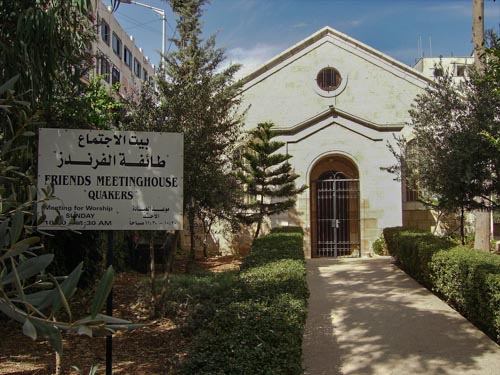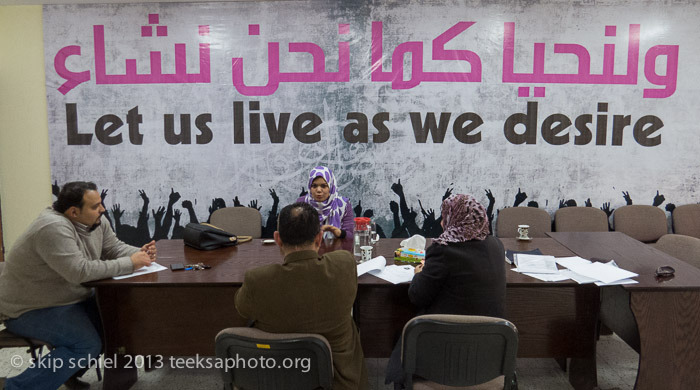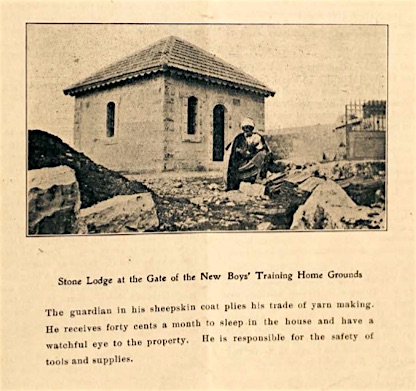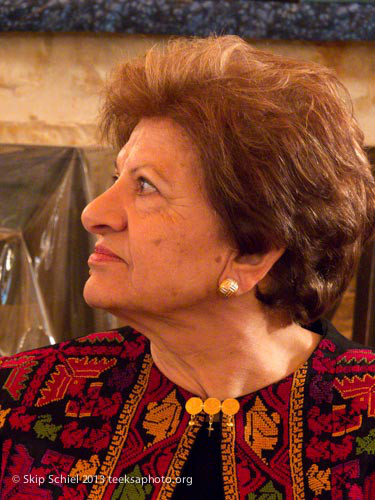
Photography of
Skip Schiel
Quakers in Israel & Palestine Time Line
(with resources)
Compiled by Skip Schiel(updated March 30, 2020)
© All text copyright Skip Schiel, 2007-2020
Drawing from the websites of Ramallah Friends School, American Friends Service Committee, Ramallah Friends Meeting, and The Ecumenical Accompaniment Program in Palestine and Israel

Ramallah Friends Meeting House, photo by Anarchopacifist—Historical photo from 1910
Ramallah Friends School & Ramallah Friends Meeting
1869
Eli and Sybil Jones from New England and others from the United States and the UK founded a number of small schools for girls in the villages surrounding Ramallah.
1883
A clinic was opened by the Quakers, with Dr. George Hassenauer serving as the first doctor in Ramallah.
1889
Friends Girls School opened as "The Girls Training Home of Ramallah". The fifteen students who enrolled the first year came from Lydd, Jaffa, Aboud, Jerusalem, Beirut and Ramallah, and six years later the first class graduated.
1901
A Boys Training Home was founded at the urging of community members, for the purpose of providing Palestinian boys a rigorous academic program guided by the principles of the Religious Society of Friends (Quakers). The school was first housed in a building near the Friends Girls School in Ramallah and as the school grew from its initial enrolment of 15 students.
1902
The first experiments in mixed classes of boys and girls began, the two training homes for Boys and Girls had classes together for one and half hours a day and it was hailed as a great success.
1910
The Friends Meeting House in the center of Ramallah was built.
1913
The first stone of the main building laid on land bought in El-Bireh in 1905.
1914
The Friends Boys School Main Building was completed but it only came into use as a school in 1918. The Girls Training Home and the Boys School, like all other schools in Palestine, were closed throughout World War 1. During those years Turkish and then British troops occupied the buildings. British troops used the Boys School as a hospital in 1917.
1919
Both schools reopened. At the newly named Friends Girls School, day students, as well as, boarders were accepted. Electric light was first used at the schools in 1923. Building at the Girls School continued and in 1925 the remainder of the third floor was constructed. At that time the former dormitory on the second floor was converted into an assembly room and named Swift Hall in honor of Sara J. Swift of New England. The home economics cottage was built in 1929 and Whittier Hall in honor of Alice Whittier Jones in 1934. Boys first took the Palestinian Matriculation examination in Jerusalem in 1926. Rufus Jones gave the Lowell Jones Library in 1928. Tennis courts were added in 1927. Grant Hall was built in 1933.
1948
The partition of Palestine and the subsequent expulsion of many Palestinians again changed the character of the School. Friends Meeting House and the School grounds became the temporary home for refugees. School numbers swelled to accommodate refugees from the coastal cities. The White Gifts giving was instituted to give foodstuffs and money to needy families. There was a conscious endeavor to increase the Schools' scholarship support. As World War Two came to an end, once again the schools continued to struggle to be a positive influence in a troubled world.
The School had a relatively peaceful life during the Jordanian period from 1948-1967. The fifth secondary class of the Friends Girls School was added in 1956, and plans were ready for opening the sixth secondary in 1963. In 1962, four classrooms were added to Whittier Hall. During Jordanian rule, the Friends School earned a reputation throughout the Middle East as a superlative educational institution. Attracted by the educational practices, expectations of student discipline, and commitment from faculty and staff, students all across the Middle East came to the Ramallah Friends School, a legendary boarding school at its time, to complete their studies. This period of School history also engendered many successful alumni who have attained prosperous careers in various professions throughout the world.
1950s
Enrollment figures for the FBS rose dramatically, reaching a peak in 1966 at 320 students. Altho New England yearly meeting had been a prime benefactor, because of the transfer of ownership to Friends United Meeting, interest from New England Friends drops precipitously.
1967Following Israeli occupation, the boarding sections in both schools were closed, as students from neighboring countries were no longer able to come. The enrollment figure for the class of 67/68 plummeted to 180, compared to the previous year of 320. Gradually, enrollment figures began to rise steady. In less than a decade, the student population would reach 350, and would continue to rise steadily thereafter.
Since the very earliest years of the School's foundation, both boys and girls from the two separate campuses had shared some classes and this strategy had proved successful. Both boys and girls were always taught together from Kindergarten to Grade 2 and merged again under the science and arts Tawjihi tracks in the 11th and 12th grades. The Upper Kindergarten had begun very early in the Friends Girls School history and was permanently expanded to the Lower Kindergarten in 1983. There was a growing belief that co-education was educationally sound and could work well in Palestine. As the first Intifada, or Palestinian uprising, grew in strength, enrollment plummeted. The financial situation also put pressure on the Board to look closely at how to use the resources of the two schools more efficiently.
1976
The Play Center was founded in Amari refugee camp when 2 European Friends were visiting Ramallah.
1990
The campus of the Girls School became a co-educational Elementary School and Kindergarten and the campus of the Boys School became a co-educational High School.
1993
Following the Oslo agreements, the uneasy peace brought greater stability to the School with the emergence for the first time of a government in waiting that had a real interest in Palestinian education.
2000
The second Intifada began. Since the beginning of the second uprising, the Friends School has been in the center of towns exposed to a new level of violence with sequences of nightly shelling from Israeli tanks and light artillery and attacks by helicopter gunners. The psychological well being of our parents, students and staff was shaken and our enrollment figures fell to 370 pupils in the FBS and 540 in the FGS in 2000/2001 as families left for America and elsewhere to escape the violence. However, following each tragedy the School has recovered, maintaining its reputation as a leading academic center in the Palestinian community.
2003Following the Israeli pullout from parts of Ramallah and el-Bireh, school services have remained uninterrupted.
Jean Zaru, presiding clerk of Ramallah Friends Meeting
2004
The meeting house reopened, after being closed for 10 years because of various Israeli incursions and lack of funding. Baltimore and Philadelphia yearly meetings and other Friends worldwide make major contributions.
2005
Two Kenyan friends are appointed to serve in the school, one as teacher, Joshua Lilande, and one as Friend in Residence, Henry Mukwanja. Because of visa restrictions, Mr. Mukwanja never arrived, and Mr. Lilande left mid year because of financial problems.
2006
The Friends International Center in Ramallah (FICR), building peace with justice, opened with Kathy Bergen serving as the director.
2013
The meeting lays down FICR. Kathy Bergen retires.
Today
As of March 29, 2020, the school has temporarily closed and shifted to distance learning. Reason? The Covid-19 Pandemic
Despite everything today, the Friends School continues to demonstrate the resilience and patience of the Palestinian community keeping alive the hope and vision of a better future. The adoption of new programs during this period reflects upon this interest. In 1999, the International Baccalaureate Organization (IBO), offering students in Palestine for the first time an IB Diploma Program, accredited the School. New buildings at the Upper School were erected to accommodate more students from ASHA grants, namely the new Science Building and Multipurpose Hall, and plans are currently underway to create a new Special Needs Resource Center and Kindergarten Building with monies provided by the UNDP.
American Friends Service Committee

Gaza office of the Quaker Palestine Youth Program
Quaker work in the Middle East dates back to 1875, with the establishment of a Friends school in Lebanon. Before and during World War II, Quakers in Europe helped Jews and other persecuted minorities escape from areas under Nazi rule.
1949
Because of the experience AFSC gained in helping to resettle hundreds of thousands of refugees and displaced persons following World War II, the United Nations asked the Committee to organize relief efforts for Palestinian Arab refugees coming into the Gaza Strip. This continued until the United Nations Relief Works Agency began its operations on May 1, 1950.
1950
AFSC staff began work on agricultural development projects in Palestinian villages and with internally displaced Palestinians living in Israel.
1967
AFSC has established a child education program in Gaza and a legal aid center in Jerusalem for Palestinians living under Israeli occupation. These programs continue as independent NGOs under Palestinian leadership.
Search for Peace In the Middle East was published in 1970, and its sequel, A Compassionate Peace (1982/1989), made AFSC among the first U.S. organizations to affirm that peace in the Middle East depended upon the mutual recognition of Palestinian and Israeli rights to self-determination, including the Palestinians' right to form their own state alongside Israel.
Throughout the 1980s, quiet meetings between Israeli and Palestinian leaders helped establish good will and may, in a small way, have contributed to the success of the 1993 Oslo Accord negotiations and eventual establishment of Palestinian self-rule. This work continues.
1985
AFSC's New Israel Program worked in mixed Jewish-Arab areas in northern Israel, providing financial support for new and innovative NGOs that are working to create a more equitable society between Israel's Jewish majority and its 18% minority of Arab citizens.
The program promoted civil rights of Israeli-Arabs in the Galilee by improving access to education, employment, and housing. AFSC also promotes interagency networking and cooperation to strengthen links between Palestinian organizations in Israel and those elsewhere in the Middle East, especially Lebanon, Palestine, and Jordan.
The AFSC provided special attention to those organizations that worked in Arab-Jewish coalitions on issues such as housing preservation, building cooperatives, school improvements, youth activities, and economic development that may help them to achieve their own goals.
Currently, AFSC Quaker International Affairs representatives in Jerusalem are working with Israeli groups to educate and support young Israelis about conscientious objection and refusal, a natural area of work for an organization with roots in civilian public service programs for American conscientious objectors during World War I.
An Israeli conscientious objector (CO), Rotem Mor, program coordinator for Quaker Service, has been very helpful in connecting the program to Israeli peace groups. He has facilitated youth seminars on conscientious objection, and sponsored the first Parents of Refuser meeting, in which parents and refusers discussed their differing views of military service and strengthened their relationships. Ongoing support for young CO's and their parents helps them through the difficult process of appealing for CO status and facing and undergoing prison time. Most of these young people and their parents have become active in the peace movement and participated in actions against the Wall.
1996
The programs in Palestine focus on long-term youth development and advocacy through the Quaker Palestine Youth Program (QPYP) and to provide emergency relief as needed. QPYP follows a strategy of challenging young people from a stereotype and sometimes reality of being apathetic, marginalized, or unengaged because of lack of options, to exploring new ways in which they can contribute positively to the advancement of their societies.
QPYP has worked closely with local NGOs, educational institutions, international organizations and Palestinian Ministries in the West Bank and Gaza Strip to enhance opportunities for marginalized Palestinian youth. The Program is managed through AFSC's Ramallah and Gaza offices with support from the Middle East Regional Office.
2002
The Youth and Reconstruction Program was implemented as a response to Israeli invasions into Palestinian towns and villages. The project involves youth from the community in the reconstruction process as a means of restoring their hope and channeling their energy into constructive action. In cooperation with a newly established group in Ramallah called "Ilna"' (Arabic for "Ours"), the AFSC and youth from the community have reconstructed 3 houses to date. In the United States, work was concentrated on building awareness of the situation and fundraising for reconstruction through emergency appeals.
The Plantation of Seedlings in Sites Threatened by Confiscation Project aims to improve the income of approximately 60 Palestinian families in the Salfeet and Qalqiliya governorates by cultivating 400 dunums of agricultural land with productive seedlings. The project involves youth volunteers.
The Palestinian Diary Writing Project began in 2002 in the West Bank with providing training to young men and women on diary writing as a means of self-expression. More
2003
A civic engagement model called Public Achievement was introduced in AFSC's Youth program in Palestine. Public Achievement, originally developed by the Hubert H. Humphrey Institute of the University of Minnesota, has over the years been established in areas ridden by conflict and inadequate opportunities for young people: Northern Ireland, South Africa, Turkey, Bosnia, Israel, and now in the West Bank and Gaza through AFSC.
The Popular Achievement model focuses on inviting young people to become active citizens in their society. It teaches and/or enhances skills the youth need to be able to fully contribute to improvement and preservation of their communities as well as the society as a whole. Each PA group consists of 10-12 individuals, 14-17 years of age. Depending on the social and cultural environment the groups are either all male/all female or mixed. Each group is coordinated by one or two college aged coaches. Training of trainers' sessions brings together Gaza and the West Bank staff, partners and coaches. The participants identify the issue they want to work on during the cycle of 8 months. Then they design, implement, evaluate the project and finally present it at the festival that brings together all of the participants from West Bank and Gaza. The projects chosen by PA groups include: establishing science labs and computer centers, developing youth-focused web-sites by youth, starting up libraries, campaigning against early marriage, cultural heritage education and preservation etc. In addition to the external changes they make through their projects each participant goes though a number of personal changes that very often become apparent to their peers and families. Over the past four years over 2200 young men and women voluntarily got engaged in the program while 190 university students became coaches and facilitated "Popular achievement".
2004
AFSC published When the Rains Return: Toward Peace and Reconciliation in Palestine and Israel, prepared by an International Quaker Working Party on Israel and Palestine.
2005
Rotem and another CO Eyal Barami went on a speaking tour in a number of cities in the US. The speaking tour marked the launch of Faces of Hope an AFSC campaign supporting nonviolent resistance and refusal in Israel and Palestine.
Support for local partners:
The first ever joint delegation to Israel-Palestine sponsored by the AFSC and Interfaith Peace Builders, to help with the olive harvest and learn from people on the ground.
Due to the difficult circumstances and restrictions of movement imposed by the Israeli military, the West Bank youth program staff and participants organized festivals in two different locations.
For the first time QPYP in Gaza decided to have a festival at the end of the current Public Achievement cycle.
2013
AFSC ends the highly successful 10 year cycle of Popular Achievement programs and initiates new directions in the region: challenging and transforming militarized societies in Israel, Palestine, and the US; fostering cohesion of disparate Palestinian groups (West Bank, Gaza, and Israel primarily); supporting the boycott-divest-sanction (BDS) international campaign as called for in 2005 by Palestinian civil society; and supporting active nonviolence and social change movements to transform the occupation and inequality generally.
Previous QPYP Projects
Architectural Conservation and Community Renewal Project, was an ambitious community renewal and restoration effort launched by the QPYP. The Project targeted Al Daraj, one of the oldest and most impoverished quarters in Gaza, in a multi-sectoral effort to survey and restore buildings of significant historic importance, including a Mamluk-era bathhouse. The restoration effort was led by groups of young architects, engineers, artisans, and community workers. The Architectural Conservation and Community Renewal Project sought not only to transform the quarter from its present neglected state, but also to become a model for historical preservation and future community restoration elsewhere in Palestine.
Heritage Education Summer Program targeted school girls, aged 15-18 years, living in the Al Daraj Quarter of Gaza City. The Program aimed to strengthen their heritage education and provide an extra curricular activity that is lacking for girls.
Assistive Technology Center for the Blind - The QPYP worked closely with the Islamic University of Gaza to develop programs for special needs students. The Assistive Technology Center for the Blind, for instance, was established by the QPYP at the Islamic University of Gaza, in order to strengthen the use of IT among visually impaired university students, and to provide an accessible and suitable environment to facilitate greater independence and learning.
Web CT Project encouraged virtual learning environments as a mechanism to access greater and more diverse information and resources. The project was launched at a local university in Gaza; however, it experiences difficulties in the face of closure and restrictions placed upon movement in Gaza.
The AFSC supports the Israeli Committee Against House Demolitions in its campaign to rebuild damaged Palestinian homes in the Jerusalem area.
Youth Leadership and Community Development Project
AFSC has collaborated with Baladna, Association for Arab Youth in implementing the Youth Leadership and Community Development Project in Israel. This project aimed to set up a nation-wide Arab youth movement, operating in all the Arab localities, as well as in mixed cities. By strengthening the leadership skills and enhancing the political and social awareness of Palestinian youth in Israel, Baladna and AFSC hope to increase involvement of youth in local community development projects.
Fighting Trafficking of Women in Northern Israel
AFSC has supported Isha L'Isha, a Haifa feminist organization, in fighting the trafficking of women in Northern Israel. Since the 1990s, approximately 3,000 women each year have been brought to Israel from the Former Soviet Union to work in the sex slave market. AFSC supports Isha L'Isha in assisting and supporting the victims of the crime, in bringing about the victims' human rights as guaranteed by the State of Israel, and in lobbying for the reinforcement of an effective public policy that will punish the perpetrators of such crime.
The Ecumenical Accompaniment Program in Palestine and Israel
2002
The Ecumenical Accompaniment Program in Palestine and Israel is a World Council of Churches initiative which was established in response to a call made by the Heads of Churches in Jerusalem and Palestinian and Israeli NGOs. The mission of the EAPPI is to accompany Palestinians and Israelis in their nonviolent actions and concerted advocacy efforts to end the occupation.
Quaker Peace & Social Witness, part of the Religious Society of Friends in Britain, co-ordinates the EAPPI in Britain and Ireland, under the auspices of the World Council of Churches.
2020
This program continues strongly.
Readings & videos
BOOKS
Cause for Concern, a Quaker's view of the Palestine Problem, by Herbert Dobbing, 1970, Institute for Palestine Studies
An early and prescient perspective from a much different eraA Compassionate Peace: A Future for the Middle East, a report prepared for the American Friends Service Committee, by Everett Mendelsohn, 1982, Hill and Wang
"Emphasizes that a compassionate spirit, if adopted by the conflict's participants, is a vital first step toward a reasoned and just peace"Friends in Palestine, by Christina H. Jones, 1981, Prinit Press
Mostly about the Ramallah Friends SchoolOccupied with Nonviolence, a Palestinian Woman Speaks, by Jean Zaru, presiding clerk of Ramallah Friends Meeting, 2008, Fortress Press
Life on the ground by a Quaker woman living in RamallahQuakers in the Israeli-Palestinian Conflict, the Dilemmas of NGO Humanitarian Activism, by Nancy Gallagher, 2007, American University in Cairo Press
Concentrates on the role of the American Friends Service Committee from 1947 to the presentSumoud: Voices and Images of the Ramallah Friends School, by Betsy Brinson and Gordon Davies, 2014, Friends United Press
Oral histories about the Ramallah Friends SchoolWhen the Rain Returns, Toward Justice and Reconciliation in Palestine and Israel, by the International Quaker Working Party on Israel and Palestine, 2004, American Friends Service Committee
By a team exploring different regions and perspectives in Palestine-IsraelPlease see additional list of suggested literature.
VIDEOS
New Hope for Peace, What America Must Do To End the Israel-Palestine Conflict, a video by Landrum Bolling, 2009
Discussion with President Jimmy Carter, James Baker, Brent Scowcroft, and Zbigniew Brzezinski, available on Youtube at https://www.youtube.com/watch?v=CoXuRJVpB8APlease see additional list of suggested visual media.
WEBSITES
American Friends Service Committee
Israel-Palestine Working Group of New England Yearly Meeting
British Quakers and Palestine-Israel
Friends’ monthly and yearly meetings—minutes and statements
Palestine Israel Action Group (PIAG) at Ann Arbor meeting
Quaker Palestine Israel Network (QPIN)
Coordinating Quaker Efforts to Bring Peace and Justice to Palestinians and Israelis

